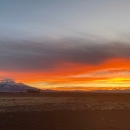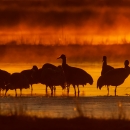About Us
The Baca National Wildlife Refuge was established to help protect water resources in the San Luis Valley and the fragile Great Sand Dunes ecosystem, along with some of the most important ecological, cultural, and wildlife resources of the Valley. Water is the lifeblood of the San Luis Valley. The runoff from the surrounding mountains and ground water flows are crucial to the many land uses in the valley. These waters create a network of riparian riparian
Definition of riparian habitat or riparian areas.
Learn more about riparian corridors and wetlands that break up large expanses of desert and upland habitats, resulting in high plant diversity. This habitat combination creates tremendous foraging and nesting opportunities for a variety of bird species and other wildlife.
Upland Shrublands
Shrublands are the most common natural habitat on the San Luis Valley floor. Many of the plants are drought resistant and tolerant of high soil salinity. Shrubs dominate the landscape. The majority of shrubs are rubber rabbitbrush, greasewood, and four-wing saltbush. Native grasses in this habitat include Indian rice grass, alkali sacaton, and blue grama.
Common wildlife species include Brewer’s sparrow, mourning dove, western meadowlark, and loggerhead shrike. Some grassland areas support rare grassland-dependent species such as the burrowing owl and long-billed curlew. Two globally vulnerable subspecies of small mammals, the silky pocket mouse and the thirteen-lined ground squirrel, are also grassland dependent. There is one globally vulnerable subspecies of butterfly, the sandhill skipper, that only lives in the San Luis Valley. Elk and pronghorn are abundant on uplands and other habitat types of the Refuge.
Wet Meadow Wetlands
Wetlands include wet meadows, seasonal wetlands, and semi-permanent wetlands. Wet meadows on the Refuge are mostly dominated by sedge and baltic rush. These wet meadows offer tremendous foraging and nesting opportunities to a variety of wetland birds including, Wilson’s phalarope, sora, Virginia rail, white-faced ibis, American avocet, Wilson’s snipe, and numerous species of waterfowl. In addition, these wet meadows provide habitat for a variety of rare or unique amphibian species such as northern leopard frog and Plains spadefoot toad.
Playa Wetlands
Playa wetlands are the largest wetland type on the Refuge. The playas are found in the western portions along the historic Saguache and San Luis Creek drainages and at the terminal reaches of streams originating in the Sangre de Cristo range. These wetlands have an intermittent water schedule.
In recent years, this habitat has remained mostly dry with only small portions receiving water and only for a short time. During wetter years, playas fill during spring with runoff and occasionally again in late summer by thunderstorms. When the playas receive water, the fleeting nature of these wetlands adds to their uniqueness and high productivity. The drying and wetting cycle cause a burst of invertebrates, a valuable food resource for numerous bird species.
Plant species in the playas range from common spikerush and three square bulrush, which occur in areas where water is present for only 1 to 3 months, to horned pondweed and hardstem bulrush in areas where water lasts more than 3 months. Mud flats are also present in areas where soil salts are less abundant. Wilson’s phalarope, American avocet, white-faced ibis, and black-necked stilt regularly use this habitat when water is present. Several species of amphibians such as chorus frog, Northern leopard frog, and Great Plains toad are also found when the playas have water.
Riparian Habitats
The Refuge has a variety of woody and non-woody riparian habitats along the six creeks flowing onto it from the Sangre de Cristo Mountains. This habitat, a very small percentage of the overall Refuge landscape, contains some of the richest species diversity of any of the other habitat types.
Woody riparian habitats contain primarily narrowleaf cottonwood with an understory of coyote willow and some peach-leaf willow. Non-woody riparian areas are dominated by sedges, rushes, and native grasses. Many birds such as the American kestrel, great horned owl, northern flicker, American robin, yellow warbler, and Bullock's oriole can be seen regularly using the riparian areas. In addition, a unique native fish community exists in the perennial portions of Crestone Creek. Four of the six native fish include the Rio Grande sucker (state endangered), Rio Grande chub (state species of concern), fathead minnow, and longnose dace are found in this creek.
Our Mission
Vision Statement
The San Luis Valley National Wildlife Refuge Complex, set in a high expansive desert valley, is cradled between the snowcapped peaks of the San Juan and Sangre de Cristo Ranges. Mountain snowmelt feeds the Rio Grande, numerous streams, and a dynamic ground water system creating a diverse mix of playas, wet meadows, and willow and cottonwood riparian riparian
Definition of riparian habitat or riparian areas.
Learn more about riparian corridors that are in stark contrast with the surrounding arid landscape. As reflected by 12,000 years of human history in the valley, the refuge complex attracts many people. Visitors experience the ancient song of the sandhill crane, witness evening flights of thousands of waterfowl, and listen to bugling elk. Through ever changing conditions like climate change climate change
Climate change includes both global warming driven by human-induced emissions of greenhouse gases and the resulting large-scale shifts in weather patterns. Though there have been previous periods of climatic change, since the mid-20th century humans have had an unprecedented impact on Earth's climate system and caused change on a global scale.
Learn more about climate change , the refuges support and foster a collaborative spirit between their neighbors and partners to conserve the valley’s treasured resources.
Our History
Before the establishment of the Baca National Wildlife Refuge, the property was a private cattle ranch for more than 100 years. The Refuge was authorized by Public Law 106-530 on November 22, 2000, as part of the Great Sand Dunes National Park and Preserve Act of 2000. The authorized Refuge boundary is about 92,500 acres and is located in Saguache and Alamosa counties. In addition to authorizing the establishment of Baca National Wildlife Refuge, the act recognized the significant diversity of resources within the Great Sand Dunes ecosystem and elevated the former national monument national monument
A national monument is established by executive order of the president or by Congressional legislation. The Antiquities Act authorizes the president to proclaim “historic landmarks, historic and prehistoric structures, and other objects of historic or scientific interest” as national monuments. The National Wildlife Refuge System helps manage two national monuments: Hanford Reach National Monument in Washington state and World War II Valor in the Pacific National Monument in Hawaii, Alaska and California.
Learn more about national monument to a national park. Section 6 of the act established Baca National Wildlife Refuge under the authority of the National Wildlife Refuge System Administration Act as amended by the Improvement Act. It also called for the protection of water resources, requiring the Secretary of Interior to “(1) protect and maintain irrigation water rights necessary for the protection of monument, park, preserve, and refuge resources and uses; and (2) minimize to the extent consistent with the protection of national wildlife refuge national wildlife refuge
A national wildlife refuge is typically a contiguous area of land and water managed by the U.S. Fish and Wildlife Service for the conservation and, where appropriate, restoration of fish, wildlife and plant resources and their habitats for the benefit of present and future generations of Americans.
Learn more about national wildlife refuge resources, adverse impacts on other water users.” The legislation, which received widespread support, focused not only on protecting the region’s hydrology, which the unique sand dunes ecosystem depends on, but also on protecting the exceptional ecological, cultural, and wildlife resources of the area.
In May 2005, the Service finalized a conceptual management plan to serve as a guide for managing the Baca National Wildlife Refuge until a comprehensive conservation plan could be developed. Interim goals include 1) evaluating pre-acquisition management strategies in relation to wetland, upland, and riparian riparian
Definition of riparian habitat or riparian areas.
Learn more about riparian habitats; 2) assembling resource information; 3) assembling visitor services information and needs; 4) assembling operational and funding needs; 5) maintaining and evaluating pre-acquisition irrigation strategies; and 6) ensuring law enforcement protection. Since passage of the authorizing legislation for the Refuge, there has been little additional funding for managing the Refuge Complex so staffing has been limited.
In 2009, Section 6 of the Great Sand Dunes National Park and Preserve Act was amended to explain the purpose and provide for the administration of Baca National Wildlife Refuge (Public Law 111-8; Omnibus Appropriations Act, March 11, 2009). The purpose of the Baca National Wildlife Refuge is to “restore, enhance, and maintain wetland, upland, riparian, and other habitats for native wildlife, plant, and fish species in the San Luis Valley.” In administering the Baca National Wildlife Refuge, the Secretary shall, to the maximum extent practicable, “(A) emphasize migratory bird conservation; (B) take into consideration the role of the Refuge in broader landscape conservation efforts; and (C) ‘[subject to any agreement in existence as of the date of enactment of this paragraph, and to the extent consistent with the purposes of the refuge], use decreed water rights on the refuge in approximately the same manner that the water rights have been used historically.’”
Other Facilities in this Complex
About the Complex
The San Luis Valley National Wildlife Refuge Complex is made up of the Alamosa, Monte Vista, and Baca National Wildlife Refuges and is an area set aside for migratory birds and resident wildlife. These Refuges are part of the National Wildlife Refuge System, a network of lands set aside and managed by the U.S. Fish and Wildlife Service specifically for wildlife. The Refuge System is a living heritage, conserving wildlife, and habitat for people today and generations to come.
The 12,026 acre Alamosa National Wildlife Refuge includes wetland areas, riparian riparian
Definition of riparian habitat or riparian areas.
Learn more about riparian corridors, wet meadows, and river oxbows. The wetland and river habitats provide a wildlife oasis in this dry region. These habitats support a variety of wildlife, including songbirds, water birds, raptors, deer, beavers, coyotes, and more.
The artificially created wetlands on Monte Vista National Wildlife Refuge’s 14,804 acres are intensively managed to provide habitat for a wide variety of waterfowl and other water birds. Mallards, pintails, teals, and Canada geese are common, as are American avocets, killdeers, white-faced ibises, egrets, and herons. Irrigation canals and wells provide precious water to maintain this important habitat.
The 93,000 acre Baca National Wildlife Refuge is a highly diverse combination of shrublands, grasslands, wet meadows, playa wetlands, and riparian areas. This Refuge was set aside not only as a haven for migratory birds and resident wildlife, but also as an important piece in a broader conservation effort to protect the wildlife, habitat, and water of the north and eastern portions of the San Luis Valley.


